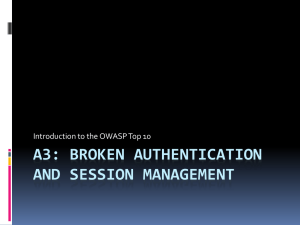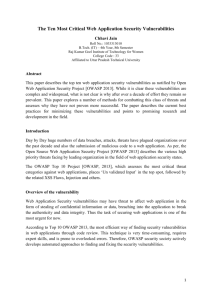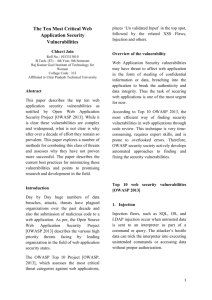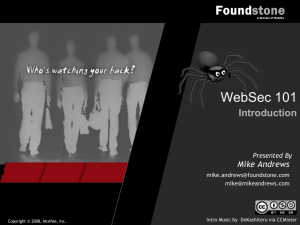OWASP Web Vulnerabilities and Auditing
advertisement
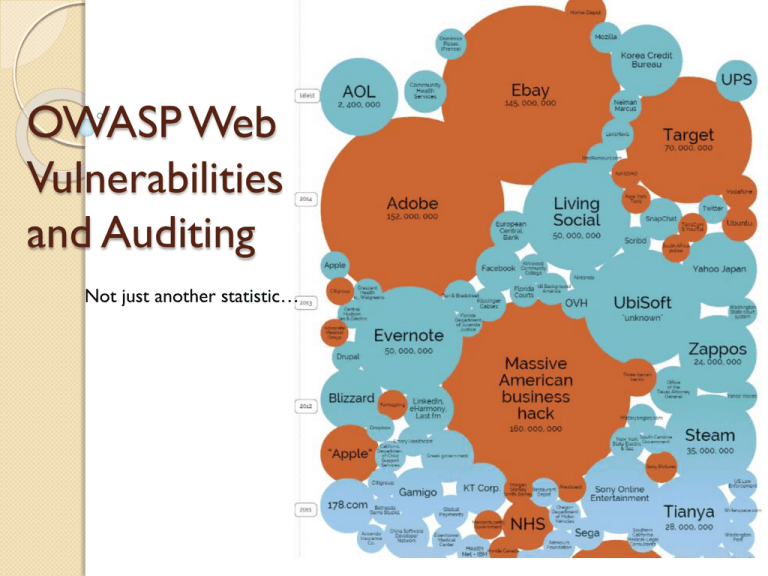
OWASP Web Vulnerabilities and Auditing Not just another statistic… What we are going to cover… Review of OWASP.org OWASP Top 10 Web Application Audit Plan 2 Highlights - 2014 Symantec Internet Security Report Key Findings 91% increase in targeted attacks campaigns in 2013 62% increase in the number of breaches in 2013 Over 552M identities were exposed via breaches in 2013 23 zero-day vulnerabilities discovered 38% of mobile users have experienced mobile cybercrime in past 12 months Spam volume dropped to 66% of all email traffic 1 in 392 emails contain a phishing attacks Web-based attacks are up 23% 1 in 8 legitimate websites have a critical vulnerability 3 OWASP who , what , why ? Open Web Application Security Project (OWASP) Our mission is to make software security visible, so that individuals and organizations worldwide can make informed decisions about true software security risks. The OWASP Foundation came online on December 1st 2001 it was established as a not-for-profit charitable organization in the United States on April 21, 2004 to ensure the ongoing availability and support for our work at OWASP advocate approaching application security as a people, process, and technology problem 4 The OWASP Top 10 - 2013 A1 Injection A2 Broken Authentication and Session Management A3 Cross-Site Scripting (XSS) A4 Insecure Direct Object References A5 Security Misconfiguration A6 Sensitive Data Exposure A7 Missing Function Level Access Control A8 Cross-Site Request Forgery (CSRF) A9 Using Components with Known Vulnerabilities A10 Unvalidated Redirects and Forwards 5 A1 Injection Injection means… • Tricking an application into including unintended commands in the data sent to an interpreter Typical Impact: SEVERE • Usually severe. Entire database can usually be read or modified • May also allow full database schema, or account access, or even OS level access Security & Risk Attackers use tools to detect and launch injection attacks that run on the internet 24 / 7. This is often common for application to have a flaw and is hard to detect during normal quality assurance tests for functionality. Exploitability: EASY 6 A2 Broken Authentication and Session Management HTTP is a “stateless” protocol • Means credentials have to go with every request • Should use SSL for everything requiring authentication Typical Impact: SEVERE • User accounts compromised or user sessions hijacked Security & Risk Attackers use tools to look for systems that have flaws in the authentication or session management. Attackers look to use trusted accounts to perform action against systems. Typically targeting admin or user who might have a higher level of permissions. Exploitability: AVERAGE 7 A3 Cross-Site Scripting (XSS) Occurs any time… • Raw data from attacker is sent to an innocent user’s browser Typical Impact: MODERATE • Steal user’s session, steal sensitive data, rewrite web page, redirect user to phishing or malware site • Most Severe: Install XSS proxy which allows attacker to observe and direct all user’s behavior on vulnerable site and force user to other sites Security & Risk Attacker can craft emails or links in online forms which appear to be valid when looking at the domain but contain coding to infect or steal cookie information. Attackers also try and embed XSS coding into databases which propagate advertisements and or other trusted social media data streams. Exploitability: AVERAGE 8 A4 Insecure Direct Object References How do you protect access to your data? • This is part of enforcing proper “Authorization”, along with A7 – Failure to Restrict URL Access Typical Impact: MODERATE • Users are able to access unauthorized files or data Security & Risk Attacker who is authorized can simply manipulates parameter values to gain access to information. Exploitability: EASY 9 A5 Security Misconfiguration Web applications rely on a secure foundation • Everywhere from the OS up through the App Server Typical Impact: MODERATE • Install backdoor through missing OS or server patch • Unauthorized access to default accounts, application functionality or data, or unused but accessible functionality due to poor server configuration Security & Risk Attackers use tools to detect by scanning for services and versions. These tools check patch levels and known vulnerabilities. They even can provide the attack package for any number of attacks or backdoors. Exploitability: EASY 10 A6-Sensitive Data Exposure Storing and transmitting sensitive data insecurely • Failure to properly protect this data in every location • Failure to identify all sensitive data • Failure to identify all the places that this sensitive data gets stored Databases, files, directories, log files, backups, etc. Typical Impact: SEVERE • Attackers access or modify confidential or private information • e.g, credit cards, health care records, financial data (yours or your customers) • Attackers extract secrets to use in additional attacks • Company embarrassment, customer dissatisfaction, and loss of trust, Expense of the incident, Fines Security & Risk Attackers typically don’t break crypto directly. They break something else such as steal the keys or perform man in the middle attacks getting the into after or before 11 encryption. Exploitability: DIFFICULT A7 Missing Function Level Access Control How do you protect access to URLs (pages)? Or functions referenced by a URL plus parameters ? • This is part of enforcing proper “authorization”, along with A4 – Insecure Direct Object References Typical Impact: Moderate • Attackers invoke functions and services they’re not authorized for • Access other user’s accounts and data • Perform privileged actions Security & Risk Attacker, who is using an authorized system user can change URLs or parameters to run a privileged function. Exploitability: EASY 12 A8 Cross Site Request Forgery (CSRF) Cross Site Request Forgery • An attack where the victim’s browser is tricked into issuing a command to a vulnerable web application • Vulnerability is caused by browsers automatically including user authentication data (session ID, IP address, Windows domain credentials, …) with each request Typical Impact: MODERATE • Initiate transactions (transfer funds, logout user, close account) • Access sensitive data • Change account details Security & Risk Victims unknowingly perform transactions while having an authenticated session. Adding pins and captcha are ways to try and avoid these attacks. Exploitability: AVERAGE 13 A9 Using Known Vulnerable Components Vulnerable Components Are Common • Some vulnerable components (e.g., framework libraries) can be identified and exploited with automated tools • This expands the threat agent pool beyond targeted attackers to include chaotic actors Typical Impact: MODERATE • Full range of weaknesses is possible, including injection, broken access control, XSS ... • The impact could range from minimal to complete host takeover and data compromise Security & Risk Virtually every application has these issues because most development teams don’t focus on ensuring their components/ libraries are up to date. Exploitability: AVERAGE 14 A10 Unvalidated Redirects and Forwards Web application redirects are very common • And frequently include user supplied parameters in the destination URL • If they aren’t validated, attacker can send victim to a site of their choice Typical Impact: MODERATE • Redirect victim to phishing or malware site • Attacker’s request is forwarded past security checks, allowing unauthorized function or data access Security & Risk User’s have become more accustom to looking at the beginning of a link and the domain. This attack uses a trusted site to redirect to malware when clicked. Exploitability: AVERAGE 15 Web Application Audit Plan 16 OWASP Testing Framework v3 Passive Phase Information Gathering Active Phase (9 sub-categories, 66 total controls) Configuration Management Business Logic Testing Authentication Testing Authorization testing Session Management Testing Data Validation Testing Denial of Service Testing Web Services Testing Ajax Testing 17 OWASP Testing Framework v3 Passive Phase Information Gathering Robots.txt Search Engine Discovery/Reconnaissance Google, Bing Identify application entry points Open Ports (nmap) Web Application Fingerprint Type and Version of OS (netcat, httprint) Application Discovery Different Base URLs (http://www.example.com/url1) Non-Standard Ports (http://www.example.com:2000/) Virtual Hosts (www.example.com, helpdesk.example.com) Analysis of Error Codes Web Server and Associated Components (OpenSSL, PHP) 18 OWASP Testing Framework v3 Active Phase (9 sub-categories, 66 total controls) Configuration Management Appropriate Configurations for Web Server, DB, and OS Business Logic Testing Bypassing Business Rules and Workflows Authentication Testing Default User IDs and Passwords, Bypassing Authentication Authorization Testing Privilege Escalation 19 OWASP Testing Framework v3 Active Phase (9 sub-categories, 66 total controls) Session Management Testing CSRF, Session Management Data Validation Testing Cross Site Scripting (XSS), SQL Injection Denial of Service Testing Locked User Accounts, Failure to Release Files and/or Memory Web Services Testing Ajax Testing 20 OWASP Testing Framework v3 21 OWASP Testing Framework v3 http://zero.webappsecurity.com 22 A1 Injection Deficiency: Post-query script found. A buffer overflow exists in post-query that allows an attacker to gain full access to the system. Recommendation: Remove the default script from the server. 23 A1 Injection 24 A2 Broken Authentication and Session Management Deficiency: Access to the privileged remote site administration page does not require authentication. Recommendation: Restrict access to privileged pages. 25 A2 Broken Authentication and Session Management 26 A3 Cross-Site Scripting (XSS) Deficiency: Cross-Site Scripting vulnerability found in Get parameter “searchTerm” that can allow an attacker to embed malicious scripts in the page and then execute the script on the machine of any user that views the site. Recommendation: User input should be validation, and encoding all user supplied data to prevent inserted scripts being sent to end users in a format that can be executed. 27 A3 Cross-Site Scripting (XSS) 28 Resource Links OWASP - https://www.owasp.org/ CIS - http://www.cisecurity.org/ NIST - http://csrc.nist.gov/ InformationIsBeautiful http://www.informationisbeautiful.net/visualizations/w orlds-biggest-data-breaches-hacks/ Internet Security Threat Report http://www.symantec.com/security_response/publicati ons/threatreport.jsp 29 Questions 30


